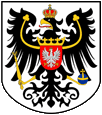Posen |
|
|
|
| Übersicht – Contents: | |
Diese Seite ist Teil des Projektes
Flaggen – Flags: |
|
 |
1886–1920, |
 |
1886–1920, |
|
|
|
historische Flagge – historical Flag: |
|
 |
1815–1886, Flagge der Provinz – flag of the province, Quelle/Source, nach/by: Flags of the World |
|
|
|
Bedeutung/Ursprung der Flagge – Meaning/Origin of the Flag: |
|
| Die Flagge des Großherzogtums und auch der Provinz Posen war zunächst eine Flagge in den polnischen Farben Rot und Weiß, denn Posen war polnisches Kronland gewesen. Im Zuge der Germanisierung wurde diese Flagge zugunsten einer Kombination aus den preußischen Farben Schwarz und Weiß abgeschafft. Jedoch zeigte der Adler im Brustschild noch immer den gekrönten polnischen Adler. | The flag
of the Grand Duchy and even of the Province of Posen was initially a flag in
the Polish colors red and white, because Posen was a Polish crown-land.
In context with the germanization this flag was abolished to favor of a combination from the Prussian colors black and white. However the eagle showed in the breast shield still the crowned Polish eagle. |
| Quelle/Source: Volker Preuß | |
|
Lesen Sie hier:
Hintergründe, Geschichte und Fakten zum Thema "Der Adler in der Heraldik"; Ausführungen, Varianten und Entwicklung. |
 |
Wappen – Coat of Arms: |
|
 |
Wappenschild von Posen – coat of arms of Posen, Quelle/Source: Wikipedia (D) |
|
|
|
Bedeutung/Ursprung des Wappens – Meaning/Origin of the Coat of Arms: |
|
| Die Ursprünge der preußischen Heraldik sind im Königlich-Polnischen Preußen zu suchen, als diese Gebiete (Pomerellen [das spätere Westpreußen], Kulmer Land, Marienburg und Elbing) 1466 vom Deutschen Orden an das Königreich Polen abgetreten und ein Lehen des Polnischen Königs wurden. Für dieses Land wurde ein Wappen geschaffen. Es zeigte den polnischen Adler in Schwarz auf silbernem (weißem) Untergrund mit einem Schwertarm. Die Farben wurden wahrscheinlich nicht zufällig gewählt, immerhin war das Königlich-Polnische Preußen vorher Territorium des Deutschen Ordens, dessen Farben Schwarz und Weiß waren (Schwarzes Kreuz auf weißem Grund). Im Jahre 1525 wandelt Hochmeister Albrecht den verbliebenen Ordensstaat (im Prinzip das Gebiet des späteren Ostpreußen, jedoch ohne das Bistum Ermland) in das weltliche Herzogtum Preußen um, Albrecht wird Herzog und schwört dem polnischen König den Lehenseid. Wieder wurde dafür ein Wappen geschaffen, wieder nach den gleichen Prinzipien. Es zeigte den polnischen Adler in Schwarz auf silbernem (weißem) Untergrund und er hatte ein gekröntes Brustschild mit der Initiale "S" des polnischen Königs Sigismund. Damit war das Wappen Preußens geschaffen. Später, als Preußen in Provinzen eingeteilt wurde, wurde dieses preußische Ur-Wappen zum Wappen der Provinz Ostpreußen, jedoch ohne das Brustschild mit dem "S", das schon 1557 mit dem Wegfall der polnischen Lehenshoheit obsolet geworden war. Anlässlich der Polnischen Teilungen konnte Preußen im Jahre 1772 das Königlich-Polnische Preußen wieder erweben. Dessen Wappen (Der Adler mit dem Schwertarm) wurde für die spätere Provinz Westpreußen übernommen. |
The origins of the Prussian heraldry can be found in Royal Polish Prussia
when these areas (Pomerelia [later West Prussia], Kulm Land, Marienburg and
Elbing) were ceded to the Kingdom of Poland in 1466 and became a fief of the
Polish king. A coat of arms was created for this country. It showed the
Polish eagle in black on a silver (white) background with a sword arm. The colors were probably not chosen at random, after all, the Royal Polish Prussia was previously a territory of the Teutonic Order, the colors of the order were black and white (black cross on a white background). In 1525, Grand Master Albrecht converted the remaining State of the Teutonic Order (in principle the area of what would later become East Prussia, but without the Diocese of Warmia) into the secular Duchy of Prussia, Albrecht became the duke and swore the oath of fief to the Polish king. Another coat of arms was created for this, again according to the same principles. It showed the Polish eagle in black on a silver (white) background and it had a crowned breastplate with the initial "S" of the Polish king Sigismund. The coat of arms of Prussia was thus created. Later, when Prussia was divided into provinces, this original Prussian coat of arms became the coat of arms of the province of East Prussia, but without the breastplate with the "S", which had already become obsolete in 1557 when the Polish feudal sovereignty ceased to exist. On the occasion of the Polish divisions, Prussia was able to gain Royal Polish Prussia in 1772. Its coat of arms (the eagle with the sword arm) was adopted for the later province of West Prussia. |
| Dieser schwarze Adler auf Weiß taucht so in den meisten Wappen der Provinzen von Preußen auf, vor allem jedoch im östlichen Teil des Landes, wo die Wurzeln von Preußen liegen. Der Adler im Wappen von Posen zeigte im Brustschild den gekrönten polnischen Adler. | This black eagle on white background appears in most of the coats of arms of the
provinces of Prussia, but especially in the eastern parts of the country,
where the roots of Prussia lie. The eagle in the coat of arms of Posen showed
the crowned Polish eagle in the breast shield. |
| Quelle/Source: Volker Preuß | |
| Landkarte – Map: | |
|
|
| Die historische Landkarte zeigt die Provinz Posen um das Jahr 1890, im Norden (in violett) die Grenze zu Westpreußen, im Westen (in Grün) die Grenze zu Brandenburg, im Süden (in Gelb) die Grenze zu Schlesien, und im Osten (in Rot) die Außengrenze des Deutschen Reiches. | The historical map shows the province of Posen around the year 1890, in the north (in violet) the border with West Prussia, in the west (in green) the border with Brandenburg, in the south (in yellow) the border with Silesia, and in the east (in red) the outer border of the German Empire. |
Zahlen und Fakten – Numbers and Facts: |
|
|
|
|
|
|
|
|
|
|
|
|
Geschichte: |
|
1. Jhd. · Besiedelung durch Germanen (Goten) 3. Jhd. · Besiedelung durch Slawen um 1250 · deutsche Besiedelung ca. 900 bis 1793 · zum polnischen Staat → "Wielkopolskie" ("Großpolen") 1793 · Zweite Polnische Teilung, an Preußen 1807–1813 · zum Herzogtum Warschau 1813–1815 · russische Militärverwaltung 1815–1830 · preußisches Großherzogtum Posen 1830 · Warschauer Aufstand 1830–1920 · preußische Provinz Posen 1920–1939 · zum polnischen Staat 1939 · Rückgliederung der Provinz Posen an Preußen als "Reichsgau Wartheland" → Vertreibung der polnischen Bevölkerung 1945 · sowjetische Eroberung, Annexion durch Polen → Vertreibung der Deutschen Bevölkerung 1999 · Wiedererrichtung der Woiwodschaft "Wielkopolskie" in den Grenzen der Provinz Posen |
History: |
|
1st cent. · settlement by Germanic tribes (Goths) 3rd cent. · settlement by Slavs about 1250 · German settlement ca. 900 to 1793 · to the Polish state → "Wielkopolskie" ("Great Poland") 1793 · Second Polish Division, to Prussia 1807–1813 · to the Duchy of Warsaw 1813–1815 · Russian military administration 1815–1830 · Prussian Grand Duchy of Posen 1830 · Warsaw Rebellion 1830–1920 · Prussian Province of Posen 1920–1939 · to Poland 1939 · re-annexation of the Province of Posen to Prussia as "Imperial Gau of Wartheland" → expulsion of the Polish population 1945 · soviet conquest, annexation by Poland → expulsion of the German population 1999 · re-construction of the Voivodeship of "Wielkopolskie" in the borders of the Province of Posen |
| Quelle/Source: Atlas zur Geschichte, Wikipedia (D), Schwarzbuch der Vertreibung, Discovery '97 |
Ursprung des Landesnamens – Origin of the Country's Name: |
|||||
| Der Name der Provinz geht natürlich auf den Namen der Hauptstadt der Provinz zurück, die Stadt Posen. Auf polnisch heißt sie Poznań, was auf das Wort "Poznan" zurückgehen könnte, was "Der Bekannte" heißt, oder auf das Verb "poznać", was "erkennen" heißt und so insgesamt als "bekannte Stadt" ausgelegt werden kann. | The
name of the province goes of course
back to the name of the capital of the province, the city of Posen. In Polish it is called Poznań, which could be traced back to the word "Poznan", which means "the known", or traced back to the verb "poznać", which means "recognize" and can thus be interpreted as "known city".
Quelle/Source:
Wikipedia (EN),
Volker Preuß |
| |||